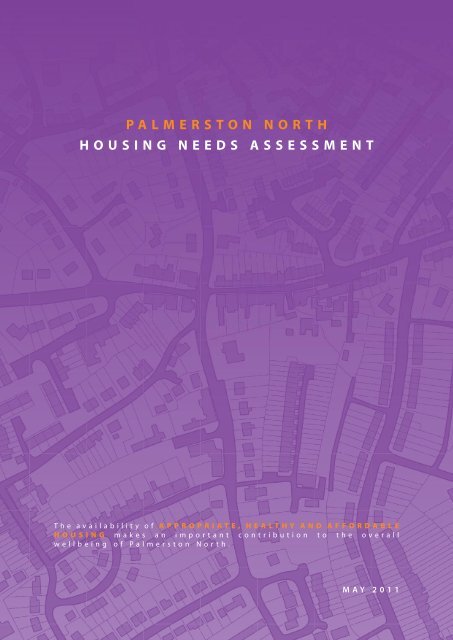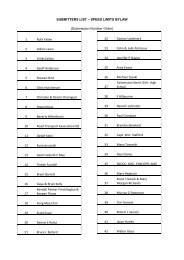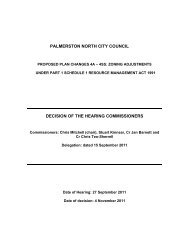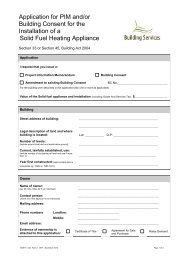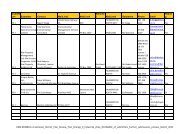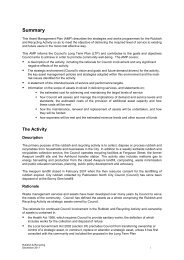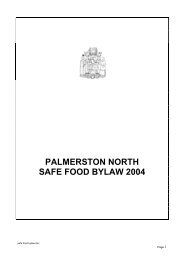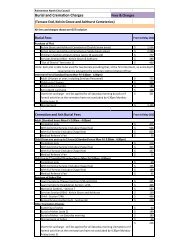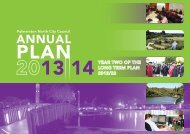PALMERSTON NORTH HOUSING NEEDS ASSESSMENT
PALMERSTON NORTH HOUSING NEEDS ASSESSMENT
PALMERSTON NORTH HOUSING NEEDS ASSESSMENT
- No tags were found...
Create successful ePaper yourself
Turn your PDF publications into a flip-book with our unique Google optimized e-Paper software.
<strong>PALMERSTON</strong> <strong>NORTH</strong><strong>HOUSING</strong> <strong>NEEDS</strong> <strong>ASSESSMENT</strong>The availability of appropriate, healthy and affordablehousing m a k e s a n i m p o r t a n t c o n t r i b u t i o n t o t h e o v e r a l lwellbeing of Palmerston North.MAY 2011
Executive Summary 2A. Statement of Purpose 5AB. Policy Context 71. National Policy Context 72. Local Policy Context 9C. Where are We Now? 111BCD1. Palmerston North People 112. Palmerston North Homes 153. Housing Market 214. Home Ownership 225. Affordability 236. Social Housing Need 26D. Emerging Issues 29Appendix One:Appendix Two:1. Aging Population and ChangingDemand for Housing 292. Quality of the Current Housing Stock 293. Housing Affordability 304. Social Housing Need 31Excerpts from The Sustainable City Strategy 32Housing New Zealand Corporation Criteria 33<strong>HOUSING</strong> <strong>NEEDS</strong> <strong>ASSESSMENT</strong> FOR <strong>PALMERSTON</strong> <strong>NORTH</strong> [ Contents ]ACKNOWLEDGEMENTThe Palmerston North Housing Needs Assessment contains information from a variety of government and nongovernmentsources. The Palmerston North City Council thanks all those agencies who have contributed tothis picture of housing needs and issues in the City.For further information please contact:Julie Macdonald | Policy Analyst | Palmerston North City Council | email: julie.macdonald@pncc.govt.nzPublished by: Palmerston North City Council
ExecutiveSummary2<strong>HOUSING</strong> <strong>NEEDS</strong> <strong>ASSESSMENT</strong> FOR <strong>PALMERSTON</strong> <strong>NORTH</strong> [ Executive Summary ]IntroductionThe availability of appropriate, healthy and affordable housing makes animportant contribution to the overall wellbeing of Palmerston North.The purpose of this Housing Needs Assessment is to inform futurediscussion about housing in Palmerston North by identifying current andemerging issues. These issues emerge from the consideration of both thenational and local contexts.Central government has a number of initiatives which contribute to the provision and regulationof housing in New Zealand. These include the provision of social housing, the oversight ofbuilding quality, initiatives to improve the quality of existing housing stock, and (through therecently announced Productivity Commission) efforts to improve the affordability of housing.Palmerston North City Council is committed to the Sustainable City Strategy, which sets guidelinesfor future development. The Council has also undertaken a Residential Growth Review and iscurrently considering the nature of future housing developments through the Residential ZoneReview.Palmerston North PeopleThe Palmerston North population is expected to grow to around 94,000 people by 2031. Thispopulation will be more ethnically diverse than the current population, and people over theage of 65 will make up a much larger proportion of the population than they do at present. Thecomposition of households is also expected to change, with a greater proportion of one-personhouseholds living in the City. The small number of older people living in residential care will alsogrow as the population profile changes.Palmerston North HousesAt the time of the 2006 Census there were almost 28,000 private occupied dwellings in PalmerstonNorth, with the majority of these homes being built since 1950. Three bedroom houses are stillthe most common type of new house.Most Palmerston North homes use electricity as their main source of heating and are thus subjectto increases in fuel price. As many houses were built prior to modern insulation standards, thereare potentially 20,000 homes with sub-standard insulation. Research indicates that New Zealandhomes are generally significantly colder than the World Health Organisation recommendationof 18°C. Such conditions can lead to dampness and condensation and, in turn, to poor healthoutcomes for residents.
Statement ofPurpose5The purpose of the Housing Needs Assessment is to identify currentand emerging housing issues in Palmerston North to inform and enablefuture discussions about housing in the City. The level of availabilityof appropriate, healthy and affordable housing makes an importantcontribution to the overall wellbeing of Palmerston North.Shelter is recognised internationally as a basic human right. Our homesinfluence our wellbeing, as do our ties to the communities in which we live andwork. 1The Palmerston North City Council (PNCC) has a number of important roles in current and futureplanning in response to housing issues. However the emerging issues affect a wide range oforganisations, and responses to them will be made by central and local government, the privatesector, community agencies, and individuals.In order to understand the context of housing issues in Palmerston North, the changing natureof the City’s population needs to be identified and understood. This understanding will, in turn,enable the diverse housing needs of the City’s population to be taken into account in longterm planning. We also need to understand the various factors which contribute to the currenthousing situation, including affordability, social need, the nature of the current housing stock,and where and how new housing is developed.For the purposes of this report ‘housing’ refers to the various forms of dwelling where PalmerstonNorth people usually reside. These include houses, flats, apartments, and retirement villages.However, the discussion here is also a broader one, recognising the social dimensions of housing,and the importance of decisions about housing for the wellbeing of the City.P A L M E r S T O N N O r T H H O U S I N G N E E D S A S S E S S M E N T [ S t a t e m e n t o f P u r p o s e ]1Housing New Zealand Corporation. (2010). Statement of Intent 2010-13.
PolicyContext71. National Policy ContextCentral government involvement in housing policy and activity covers a range of areas, includingaffordability of home ownership, suitability of current housing stock, and social housing. Thereare several government agencies with core responsibilities for housing activities (such as theHousing New Zealand Corporation, the Centre for Housing Research, the Department of Buildingand Housing, the Energy Efficiency and Conservation Authority), and many others whose mainfunctions also impact on housing issues (such as the Ministry of Social Development).Productivity CommissionIn March 2011 the Government announced the formation of a Productivity Commission, whichhas been asked to investigate and report on (among other things) housing affordability.The terms of reference (in relation to housing affordability) for the Commission are that it should:• Identify and analyse all components of the cost and price of housing.• Identify mechanisms to improve the affordability of housing, with respect to both thedemand and supply of housing and associated infrastructure.• Identify any significant impediments to home ownership, and assess the feasibility andimplications of reducing or removing such impediments.The Productivity Commission is to report to the Government by February 2012.The Department of Building and HousingThe Department of Building and Housing has an overview of the entire building and housingsector. Its main goal is to improve building quality and housing availability for all New Zealanders.EECAP A L M E r S T O N N O r T H H O U S I N G N E E D S A S S E S S M E N T [ P o l i c y C o n t e x t ]The Energy Efficiency and Conservation Authority (EECA) was established under the EnergyEfficiency and Conservation Act 2000 to encourage, support and promote energy efficiency,energy conservation, and the use of renewable sources of energy. The Warm Up New Zealand: HeatSmart programme started on 1 July 2009, and aims to retrofit more than 188,500 New Zealandhomes over a four year period. In May 2011 100,000 homes had been fitted with insulation and/or heating under the scheme. Home owners are eligible for a subsidy of 33% for insulation (upto $1,300) and $500 off the cost of a clean heating device and the installation (if insulation is upto standard).
2. Local Policy ContextThe policy and activities of national agencies provide the context within which Palmerston Northhousing is built, maintained, and lived in. Some of the agencies mentioned above have a directrole in Palmerston North, through, for example, the direct provision of housing (HNZC) or effortsto improve housing stock (EECA). Locally, the PNCC has a variety of functions which impact onhousing. These include planning and regulatory functions and the provision of social housing.Future decisions about housing in Palmerston North will be made within a policy framework.The Council has adopted a Sustainable City Strategy that sets some guiding principles for thefuture development of the City. This Strategy acknowledges that any future development will bemade within external constraints determined by factors outside of the Council’s control. Thesefactors include rising energy costs and the need to reduce greenhouse gas emissions overall. Theimplications of these factors for housing include the need for greater energy efficiency in homeheating, and ensuring the City remains compact to help minimise the need for travel by petroland diesel powered vehicles. (See Appendix One for the relevant text from the Sustainable CityStrategy). Of particular relevance here are the following objectives:• Sustainable transport: Encourage development which is close to and well linked to the cityand its facilities, with a variety of public and private transport alternatives.• Compact city: Encourage development which is close to and well linked to the city and itsfacilities.• Accessibility: development which is close to and well linked to the city and its facilities.• Housing choice: Encourage development in area(s) which would enable diversity in the city’shousing stock.The Residential Growth Review was undertaken to ensure enough land is available to meet futureland demand for housing development. The review focused on greenfield demand – rural zoneland that is currently undeveloped. The selection of the three preferred sites for future residentialgrowth included consideration of physical, environmental and social factors. Council adoptedthe Residential Growth Strategy in September 2010. Development within the three preferred siteswould not be undertaken by the Council, but rather enabled by rezoning this land as residentialwithin the District Plan.The District Plan sets out what can and cannot be done on land in the District. The ResidentialZone Review is part of the Sectional District Plan Review. 3 The purpose of this project is to reviewthe current housing development standards and consider what housing and neighbourhoodscould look and feel like in the future. The Residential Zone Review is based around five key issues:Sustainability – how to improve the sustainability of residential areas and houses.9<strong>PALMERSTON</strong> <strong>NORTH</strong> <strong>HOUSING</strong> <strong>NEEDS</strong> <strong>ASSESSMENT</strong> [ Policy Context ]Urban design – how to incorporate better design criteria (and implement the actions of theUrban Design Strategy).Residential density and subdivision – including consideration of medium density housingoptions around the Central Business District and neighbourhood centres.Reviewing bulk and location standards – consideration of the requirements for good designwhich contributes to positive residential environments.Non-residential activities – whether non-residential activities are able to be located in residentialareas.3Shaping Our City is the title of the Council's Sectional District Plan Review.
Ethnic diversityPopulation projections for the ethnic make-up of Palmerston North are currently only availableto 2021. They show that it is anticipated that there will be an increase in the actual number ofpeople identifying with each ethnic group.FIGURE 3: Projected population ethnicity structure ofPalmerston North70,00060,00013Number of people50,00040,00030,00020,00010,00001996*Source: Statistics New Zealand2001* 2006* 2011 2016Year (*is based on Census data)European or OtherMaoriAsian2021PacificThe level of increase for each ethnic group is detailed in the table below. We can see that theAsian and Pacific populations, particularly, will undergo a significant increase. Note that theethnic categories are not mutually exclusive because people can and do nominate more thanone ethnic group that they belong to and have been included in figures for each group theyidentify with.Table 1:Projected population ethnicity structure of Palmerston North (percentages)Europeanor OtherMaori Asian Pacific Totalpopulation2006 (Census) 64,500 (82%) 12,400 (16%) 6,100 (8%) 3,000 (4%) 78,5002021 (projected) 70,200 (79%) 15,900 (18%) 8,900 (10%) 4,900 (6%) 88,800Source: Statistics New Zealand<strong>PALMERSTON</strong> <strong>NORTH</strong> <strong>HOUSING</strong> <strong>NEEDS</strong> <strong>ASSESSMENT</strong> [ Where Are We Now? ]
HouseholdsNational projections for household composition over the next twenty years show that there willbe an increase in the percentage of one person households and a decrease in households madeup of families or other groups (in addition to the increase in actual household numbers as a resultof the rising population).1480%FIGURE 4: Projected households (percentages) byhousehold type (national data)<strong>PALMERSTON</strong> <strong>NORTH</strong> <strong>HOUSING</strong> <strong>NEEDS</strong> <strong>ASSESSMENT</strong> [ Where Are We Now? ]Percentage70%60%50%40%30%20%10%0%Source: Statistics New Zealand2015Family2020Year2025Other multi-person2030One-personThe projections for household composition in Palmerston North closely reflect the nationaldata, although the student population is reflected in the higher proportion of multi-personhouseholds.PercentageFIGURE 5: Projected households by household type forPalmerston North (percentages)80%70%60%50%40%30%20%10%0%2006Family20112016Year2021Other multi-person2026One-person2031Source: Statistics New ZealandAccording to Statistics New Zealand projections, the number of households in Palmerston Northwill increase to 39,000 by 2031 (from around 29,600 households at the 2006 Census). As Table 2shows, the major change will be in the increase of one-person households.
Table 2:Projected households by household type (Palmerston North)Household typeFamilyOther multipersonOnepersonTotal2011 21,300 2,400 8,000 31,7002016 22,300 2,500 8,800 33,6002021 23,100 2,600 9,700 35,400152026 23,900 2,600 10,600 37,2002031 24,600 2,700 11,600 39,000Source: Statistics New ZealandAt the time of the 2006 Census the large majority of New Zealanders aged 65 years and over livedin private dwellings. Some of these were in retirement village complexes. A very small proportionof people (around 5%) were accommodated in residential care for aged people. Applying thispercentage to Palmerston North, in 2006 around 450 people (aged 65 years and over) were livingin residential care facilities.In New Zealand overall, there has been a growth in the provision of aged-care facilities in recentyears, and this is also true of Palmerston North. For example, the number of building consents fornew apartments has increased to 9.5% of total consents for the period between 2006 and 2010,and the majority of these are in retirement complexes. Nationally, most of the recent developmentshave catered for people who have the financial means to pay for this accommodation. 72. Palmerston North HomesPeople’s homes provide more than physical shelter; they contribute to the connections weexperience with our communities and are an important contributing factor to the health andwellbeing of individuals, households and wider communities. Palmerston North City has grownas a result of various decisions made about the type of city we want to live in, as well as aregulatory framework which has changed over the years to enable and allow different types ofdevelopment. All these decisions (by generations of politicians, planners, developers, businesspeople, families, and individuals) have influenced the density and location of suburbs, and thenature and feel of the City’s housing overall.This section considers the nature of the houses in Palmerston North, while also acknowledgingthe contribution they make to broader community outcomes.<strong>PALMERSTON</strong> <strong>NORTH</strong> <strong>HOUSING</strong> <strong>NEEDS</strong> <strong>ASSESSMENT</strong> [ Where Are We Now? ]Current housing stockPalmerston North started to grow during the late 1920s to early 1930s as the City developedbigger buildings, shopping centres, parks and suburbs. In the period between 1950 and 1980 thehousing stock in Palmerston North boomed with the greatest number of new dwellings built inthe 1970s. After this the building of new houses declined.7Grant Thornton. (2010). Aged Residential Care Service Review.
FIGURE 6: Additions to dwelling stock numbers forPalmerston North by decade6,0005,00016Number4,0003,0002,000<strong>PALMERSTON</strong> <strong>NORTH</strong> <strong>HOUSING</strong> <strong>NEEDS</strong> <strong>ASSESSMENT</strong> [ Where Are We Now? ]1,0000Pre19001900Source: Howell and Birchfield (2010)1910192019301940Year195019601970198019902000to Mar2006Palmerston North has seen a growth in residential development during the 2000s. 8Percentage70%60%50%40%30%20%10%0%Source: Statistics New ZealandFIGURE 7: Residential growth comparison by typein Palmerston North 1997-20101997 1998 1999 2000 2001 2002 2003 2004 2005 2006 2007 2008 2009 2010GreenfieldYearInfillThe strongest infill growth has occurred in the Hokowhitu and Roslyn areas. Greenfielddevelopment is mostly concentrated in Kelvin Grove and Aokautere. In 2010 of the 160 buildingconsents issued, 61 were for infill housing, 69 were greenfield developments, and 30 were in ruralareas.RuralAt the time of the 1996 Census, there were around 25,236 private occupied dwellings in the City,of which 82% were separate/detached houses. Forty four percent of these were three bedroomhouses and 23% had four bedrooms.8Note that Figure 7 shows the growth in residential dwellings and does not include building consents for retirement village apartments.
FIGURE 8: Number of bedrooms in Palmerston North houses (1996)14,00012,00011,44210,000Number8,0006,0004,0002,00001,257Source: Statistics New Zealand15,511234,88741,0775Number of bedrooms225 126 132Ten years later at the time of the 2006 Census, there were almost 28,000 private occupieddwellings in Palmerston North. Over that decade, four bedroom houses replaced two bedroomhouses as the second most common type of house, and this trend has continued since then.Percentage50%45%40%35%30%25%20%15%10%5%0%219963Number of bedrooms20016720068+4579OtherFIGURE 9: Percentage of two, three, and four bedroom houses inPalmerston North (of private dwellings overall)Source: Statistics New ZealandThe average size of the 195 new houses built in 2010 in Palmerston North was 208m 2 (includingthe floor area of attached garages). This closely reflects the size of new homes being built in NewZealand overall.17<strong>PALMERSTON</strong> <strong>NORTH</strong> <strong>HOUSING</strong> <strong>NEEDS</strong> <strong>ASSESSMENT</strong> [ Where Are We Now? ]
FIGURE 10: Average floor area for new residential dwellings(excluding apartments)25020018<strong>PALMERSTON</strong> <strong>NORTH</strong> <strong>HOUSING</strong> <strong>NEEDS</strong> <strong>ASSESSMENT</strong> [ Where Are We Now? ]Square metres150100500199119921993Palmerston North19941995199619971998199920002001Year2002New Zealand200320042005200620072008200920102011Manawatu DistrictIn contrast, the average size of all houses in New Zealand, based on floor area, is 149m 2 . 9 Thedistrict with the largest average house size is Selwyn, followed by Queenstown Lakes, and thelowest is the Chatham Islands, followed by a number of other rural areas including Wairoa,Kawerau and Waikato. The average house size in Palmerston North is 153.8m 2 (ranking 60th outof the 74 local authority areas). Quotable Value (QV) notes that newer houses tend to be largerthan old ones, and so areas where there are extensive new housing developments tend to havethe highest averages overall. It should be noted that these data only reflect the size of housesand not apartments or flats.Home healthNational research shows that temperatures in New Zealand homes generally average 6°Cbelow the World Health Organisation minimum recommendation for indoor temperatures of18°C. Indoor temperatures below 18°C lead to dampness and condensation, which in turn leadto an increase in fungi and dust mites, as well as increased susceptibility to infectious disease.Accordingly, studies have also found that fungal growth affects about 40% of New Zealandhomes. 10The Building Research Association of New Zealand (BRANZ) undertakes a regular survey of NewZealand housing to monitor conditions. 11 The 2005 survey concluded the average condition ofall houses in the survey was good, with an expected difference between the older houses in thesurvey and the newer ones. However BRANZ also notes that older homes have become morepopular over past decades and that many are being modernised and upgraded. This means thatthe average condition stabilises at about the 1930s to 1950s age group and then improves fornewer homes. However the survey also found that the estimated cost of more urgent maintenancewas $3,700 per house, compared with the average annual expenditure on maintenance of lessthan $1,300 per house. Specific data are not available for Palmerston North, but it would be a fairassumption that this figure applies to houses in the City.Preliminary findings from the most recent BRANZ survey 12 suggest that the overall conditionof New Zealand houses has declined further, to between moderate and good. BRANZ suggeststhat the reason for the significant decrease in average condition could be that rental propertieswere included in the survey for the first time. If this is the case, then the implication is that thelarge proportion of Palmerston North houses in the rental market are in need of significant9QV New Zealand (2011). http://www.qv.co.nz/propertyinformation/KnowledgeCentre/Averagehousesizebyarea12042011.htm10Beacon Pathways Ltd. (2007). Indoor Environment Quality.11BRANZ. (2005). Study Report No. 142. New Zealand 2005 House Condition Survey.12BRANZ. (2011). Study Report No. 240. Preliminary BRANZ New Zealand 2010 House Condition Survey Report.
expenditure on maintenance. In response to the research, the Chief Executive of the RegisteredMaster Builders’ Federation noted that landlords are not investing in improving their properties,but were rather “doing the bare minimum” to keep them tenable. 13Much of the information that is available about New Zealand houses tends to rely on gatheringreports of residents’ perceptions, rather than surveys of the houses themselves. For example,the 2008 New Zealand Housing Survey 14 confirms that many New Zealanders live in cold, dampconditions, or in homes where there is insufficient insulation. According to survey respondentsfrom Palmerston North, 37% of homes in the City are causing health problems for the peopleliving in them, compared to the national figure of 26%. Nationally, health problems are reportedparticularly by lower income households, with Pacific people (50%) and Maori (47%) also morelikely to report health problems than the population overall (including those groups) (26%).Reports by residents can also be backed up by what we know about the existing housing stock.For example, prior to 1980, the Building Act did not require insulation in houses. This meanspotentially 20,000 houses in Palmerston North do not have any insulation. According to NewZealand research a pre-1970s home without an insulation retrofit is typically (in winter) only 1°Cwarmer than the temperature outside. 15According to EECA, between July 2009 and December 2010, 1330 homes had insulation installedunder the Warm Up New Zealand scheme and a further 225 homes had heating installed. Thesefigures only reflect the homes which received the funding subsidy available under the WarmUp New Zealand scheme. The minimum requirements for insulation have increased significantlysince 1980, but it is likely that many houses built since the 1980s (but prior to the adoption ofcurrent codes) are under-insulated and may be cold and damp. Anecdotal evidence suggeststhat some home owners have retrofitted heating and/ or insulation without the benefit of thesubsidy. Taking this into account, it still seems highly likely that the vast majority of PalmerstonNorth homes are either uninsulated or have inadequate insulation to provide warm, dry livingconditions.Sources of heatingThe large majority of Palmerston North households use electricity as a main source of fuel forheating.Number of dwellingsFIGURE 11: Fuel types to heat private occupied dwellings inPalmerston North (2006)18,00016,00014,00012,00010,0008,0006,0004,0002,0000ElectricityMainsgasBottledgasWoodCoalFuel typeSolarpowerNoneOther Notfuel(s) elsewhereincluded19<strong>PALMERSTON</strong> <strong>NORTH</strong> <strong>HOUSING</strong> <strong>NEEDS</strong> <strong>ASSESSMENT</strong> [ Where Are We Now? ]Source: Statistics New Zealand13http://stuff.co.nz/business/market-data/5003127/Kiwi-housing-in14New Zealand Business Council for Sustainable Development. (2008). 2008 New Zealand Housing Survey.15Howden-Chapman, P.M., Crane, J., Viggers, H., Cunningham, M., Blakely, T., Cunningham, C., Woodward, A., Saville-Smith, K., O’Dea, D., Kennedy, M., Baker,M., Waipara, N., Chapman, R., Davie, G. (2007). Effect of insulating existing houses on health inequality: cluster randomised study in the community. BritishMedical Journal, 224: 460-469.
Compared with New Zealand overall, a much greater percentage of Palmerston North homesuse mains gas as a heating fuel, and fewer Palmerston North households use electricity, wood, orcoal, than in the country overall. Some homes still use unflued gas appliances, which are knownto have negative health consequences. 16FIGURE 12: Fuel types used to heat dwellings inPalmerston North and New Zealand (2006)20<strong>PALMERSTON</strong> <strong>NORTH</strong> <strong>HOUSING</strong> <strong>NEEDS</strong> <strong>ASSESSMENT</strong> [ Where Are We Now? ]Percentage of dwellings80%70%60%50%40%30%20%10%0%ElectricityMainsgasBottledgasPalmerston NorthWood Coal SolarpowerFuel typeOtherfuel(s)New ZealandNote: Census respondents were able to nominate more than one source of fuel for heating.Source: Statistics New ZealandNoneNotelsewhereincludedResearch undertaken by the Ministry of Social Development and EECA found that many lowincome households experience energy poverty, defined as “the inability to afford access tosufficient energy services”. 17 Some low income households were unable to heat their homes atall, due to either a lack of space heating appliances and/or the ability to pay for heating costs. 18OvercrowdingThe availability of adequate housing space is an important indicator of household and communityhealth. The Ministry of Social Development defines household crowding as homes requiring oneor more additional bedrooms. 19 It should be noted that this measurement does not provide anyinformation about other aspects of housing suitability, such as warmth or safety. Furthermore, itdoes not reflect the perceptions people may have about their own circumstances, or necessarilylead to negative social outcomes.At the 2006 Census 10% of New Zealanders lived in households requiring one or more additionalbedrooms to adequately accommodate all members of the household. Children were foundto be more likely to live in overcrowded conditions than older people. Pacific people were farmore likely to live in crowded conditions than members of other ethnic groups. The numbers ofpeople living in crowded conditions in Palmerston North in 2006 were lower than the nationalpercentages, although the ethnic make-up of the figures roughly mirrors that of the countryoverall.16Beacon Pathways Ltd. (2010). Unflued Gas Heater Fact Bank.17Ministry of Social Development and EECA. (2010). Household Energy Affordability : Qualitative Research Report.18The Council has developed a Domestic Energy Strategy to reduce the use of non-renewable energy by households.19Ministry of Social Development. (2010). The Social Report.
FIGURE 13: Percentage of household crowding by ethnic group (2006)Percentage50%45%40%35%30%25%20%15%10%5%0%AsianSource: Statistics New ZealandEuropeanNew ZealandMaoriEthnic groupPacificPalmerston NorthThe percentage of Palmerston North people living in crowded conditions decreased between1986 (9.9%) and 2006 (6%). This also meant an actual decrease of over 2000 people during thosetwenty years. At the time of the 2006 Census, Palmerston North had around 4,542 people livingin crowded conditions. Most of these people were European New Zealanders, however Pacificpeople had the highest percentage of crowding in 2006.Number of people5,0004,5004,0003,5003,0002,5002,0001,5001,0005000Source: Statistics New ZealandFIGURE 14: Housing crowding in Palmerston Northby ethnic group (1986-2006)European1986Maori1991PacificEthnic group1996Asian2001OtherOther200621<strong>PALMERSTON</strong> <strong>NORTH</strong> <strong>HOUSING</strong> <strong>NEEDS</strong> <strong>ASSESSMENT</strong> [ Where Are We Now? ]3. Housing MarketThe impact of the recession is evident in the downturn in development in New Zealand overall,with Statistics New Zealand reporting that for February 2011 the value of residential buildingconsents had fallen $96 million (20 percent) since February 2010. In Palmerston North a slowingin development has been evident since 2007 (see Figure 15).
22<strong>PALMERSTON</strong> <strong>NORTH</strong> <strong>HOUSING</strong> <strong>NEEDS</strong> <strong>ASSESSMENT</strong> [ Where Are We Now? ]Number of building consentsFIGURE 15: Total number of building consents for residentialdwellings in Palmerston North 2000-2010450400350300250200150100500200020012002200320042005Year (* is consents issued)Number of building consents200620072008*2009*2010*5-year averageCorrespondingly, there has been a slowing of the housing market overall, nationally and inPalmerston North. QV 20 reports that in April the overall national property value was 2% lowerthan it was a year ago, and 5.9% lower than its peak value in 2007. The market has been relativelysteady overall, but there is significant regional variability. Palmerston North house sales havereflected the slow provincial house market and in April 2011 the average property value was 4%lower than it was at that time in 2010. QV notes that there were low property sales in 2010, andthat nationally there has only been a small rise in house buying activity so far in 2011.4. Home OwnershipNationally, the level of home ownership is declining. At the 2006 Census, 66.9% of householdswere in owner-occupied dwellings. This figure had declined from 70.7% at the time of the 1996Census. In 2006 only 62.9% of Palmerston North households were in owner-occupied dwellings. 21Levels of home ownership vary across the household income brackets. Figure 16 illustrates howthe 1996 levels of home ownership were higher than the 2006 levels in almost all income groups.Percentage100%90%80%70%60%50%40%30%20%10%0%Nil or LossFIGURE 16: Households in owner-occupieddwellings in Palmerston North$1-$5,000$5,001-$10,000$10,001-$15,000$15,001-$20,000$20,001-$25,0001996$25,001-$30,000$30,001-$40,000$40,001-$50,000Household income2001$50,001-$70,000$70,001 - $100,000$100,001 or moreNot ElsewhereIncludedTotal2006Source: Statistics New Zealand20http://www.qv.co.nz/aboutus/pressreleases/Propertyvaluessteady12042011.htm21Of the 73 local authority areas, only 13 have a level of home ownership lower than that national average. These include the cities of Auckland, Hamilton,Palmerston North, Porirua, and Wellington. It should be noted that this figure does not reflect the level of investment in housing overall, but rather thepercentage of home owners who live in their own home.
A more detailed breakdown of the ownership arrangements for Palmerston North households isshown in Table 3.Table 3:Housing arrangements for households in Palmerston North (2006)Palmerston NorthNew ZealandOwned or partly ownedby usual resident(s)Mortgage arrangements(no other information)49.9% 51.2%1.6% 1.8%23Who make mortgage payments 28.0% 27.9%With no mortgage payments 20.3% 21.5%Not owned by usual resident(s) 35.4% 31.1%Rental arrangements NFD 0.4% 0.4%Who make rent payments 32.3% 26.7%With no rent payments 2.7% 3.9%Held in a family trust byusual resident(s)Mortgage arrangements(no other information)14.6% 17.8%0.8% 0.9%Who make mortgage payments 4.0% 5.0%With no mortgage payments 5.3% 5.6%Not elsewhere included 4.6% 6.2%Source: Statistics New ZealandHNZC is the biggest single provider of rented accommodation in Palmerston North, althoughits share of the rental market is declining. However, of the households who are in rentedaccommodation, the large majority pay rent to private sector landlords.5. AffordabilityAffordability is usually measured by determining the number of households for whom the costof housing (either mortgage or rental payments) is 30% or more of their disposable income. 22Households who pay more than 30% in housing costs are considered to be experiencing housingstress. In 2009, 27% of New Zealand households spent more than 30% of their disposable incomeon housing costs. Since the 1980s there has been a significant increase in the proportion ofhouseholds with this level of spending. The lowest income households are over-representedhere, with around a third experiencing housing stress.<strong>PALMERSTON</strong> <strong>NORTH</strong> <strong>HOUSING</strong> <strong>NEEDS</strong> <strong>ASSESSMENT</strong> [ Where Are We Now? ]Home ownershipThere are various measures used to assess the affordability of home ownership. Measures whichare based on mortgage servicing costs show a greater improvement in affordability comparedwith those which focus on house prices and median income measures.22Ministry of Social Development. (2010). The Social Report.
The February 2011 Roost Home Loan Affordability Report 23 for Palmerston North reported that themedian house price was $267,500 in January 2011, compared with $340,000 nationally. Fiveyears ago the median for the City was $230,000, compared with $300,000 nationally. It now takes27.6% of the median household take-home pay to service a mortgage of a median priced home(purchased in January 2011). This suggests that median-priced housing is reasonably affordable24 25for families in Palmerston North, when there is more than one adult working.24<strong>PALMERSTON</strong> <strong>NORTH</strong> <strong>HOUSING</strong> <strong>NEEDS</strong> <strong>ASSESSMENT</strong> [ Where Are We Now? ]Mortgage costs can also be considered in relation to the median income. In New Zealand overall,it now takes 51.7% of one median income to pay the mortgage on a median priced house(purchased in January 2011). (A typical buyer is assumed to be in the 30-34 age years group). Thisis a decrease from 62.4% one year ago and 68.2% five years ago. Essentially the median incomefor a typical buyer is not high enough to buy a median priced house, even with a 20% deposit. 2627The comparable figure for Palmerston North is 41.5% of weekly take home pay. PalmerstonNorth compares well to many other cities (as shown in Table 4), however it is still a challenge forsingle people, or households on a single income, to be able to afford to buy their own homes.Table 4:Percentage mortgage payment as a percentage of median weekly take-home payJanuary 2011 January 2010New Zealand 51.7% 62.4%Auckland 64.6% 75.9%Hamilton 53.5% 61.2%Christchurch 53.3% 63.9%Wellington 52.0% 61.8%New Plymouth 51.4% 69.0%Napier 45.8% 60.5%Palmerston North 41.5% 48.0%Dunedin 39.1% 53.4%Source: www.interest.co.nz23Roost. (2011). Home loan affordability in Palmerston North. http://www.interest.co.nz/sites/default/files/Palmerston%20North_home_loan_affordability_Feb_2011.pdf24Roost. (2011). Home loan affordability in Palmerston North.25The profile used in the Roost Homeloan Affordability Series for a standard buyer household is one adult male working full-time, one adult female working50%, and one child aged 5 years.26Roost. (2011). Roost Homeloan Affordability Series. http://www.interest.co.nz/property/home-loan-affordability27The standard buyer index is calculated assuming that the house buyer has already has a 20% deposit. Based on current income and house prices it willtake an individual 8.4 years to save the 20% deposit now required by most banks.
Home rentalAt the time of the 2006 Census Palmerston North rents tended to be grouped towards the middleand lower range of rents paid in New Zealand overall.30%FIGURE 17: Weekly rent of households inPalmerston North and New Zealand (2006)Percentage25%20%15%10%5%0%Under $50$50–$79Source: Statistics New Zealand$80–$99$100–$124$125–$149$150–$174Palmerston North$175–$199$200–$249Weekly rental$250–$299$300–$349$350 and overNew ZealandNot elsewhereincluded(2)At March 2011 the weekly average rent paid in Palmerston North was $280, compared with theNew Zealand average rent of $320. 28 It should be noted that this figure is only an average anddoes not tell us where most rents are clustered.More usefully, a rent ratio can be calculated which tells us the relationship between medianhouse price and the median annual rent. While Palmerston North rents are relatively affordablewhen compared with other cities, it should be noted that affordability is a limited measure andgives no indication of the suitability of the property for its purpose (in terms of size or homehealth).Table 5:Rent ratio for February 2011Median house price Median 3 bedroom yearly rent Rent ratioNew Zealand $350,000 $16,640 21.0Auckland metro $465,000 $20,685 22.5Wellington metro $408,500 $19,493 21.0Christchurch $341,434 $17,160 19.9Hamilton $317,000 $16,640 19.1Napier $313,125 $16,640 18.8New Plymouth $312,750 $16,640 18.8Palmerston North $272,500 $14,560 18.7Dunedin $245,000 $15,600 15.725<strong>PALMERSTON</strong> <strong>NORTH</strong> <strong>HOUSING</strong> <strong>NEEDS</strong> <strong>ASSESSMENT</strong> [ Where Are We Now? ]Source: www.interest.co.nz28Interest.co.nz (2011). The ratio between New Zealand house prices and rents. The rent ratio.
6. Social Housing NeedHousing New Zealand CorporationIn Palmerston North there are currently 1,523 HNZC properties (see Table 6). The majority ofthese homes have two or three bedrooms. A small number of these properties are not rented toindividuals or families, but rather provide accommodation for organisations to provide housing(e.g. refuges).26<strong>PALMERSTON</strong> <strong>NORTH</strong> <strong>HOUSING</strong> <strong>NEEDS</strong> <strong>ASSESSMENT</strong> [ Where Are We Now? ]HNZC acknowledges that, nationally, there are high-priority applicants with unmet housingneeds. Furthermore, many state houses need significant upgrading to current standards sothat homes are suitable for modern-day living. The current portfolio of houses still requires(approximately) a further $1.7 billion in upgrading expenditure to bring the amenities up to anacceptable standard.Table 6:Total HNZC properties in Palmerston North City by age and bedroom size (as at 27 March 2011)BedroomsAge of unit (years) Bedsits 1 2 3 4 5 6 7 Total1-10 4 1 511-20 1 22 5 1 2921-30 12 104 18 5 13931-40 18 132 128 27 1 30641-50 4 45 110 155 25 1 34051-60 4 38 38 217 31 1 32961-70 50 165 73 12 30071-80 12 31 12 1 5681-90 5 7 1 1391-100 3 2 1 6Total 8 176 614 617 105 1 1 1 1,523Source: HNZCHNZC reports that demand for housing in Palmerston North is moderate when compared withsimilar centres such as Napier, Hastings, or Dunedin. Because the cost of rental accommodationin Palmerston North is generally reasonable, demand for HNZC housing is more likely to stemfrom a wide variety of complex needs (and not be solely due to cost). At present around half ofthe HNZC properties have long term tenants, and half turn over reasonably regularly. The changeto HNZC’s national policy will mean that from July 2011 tenancies will become fixed term, andthen reviewable.The waiting list for HNZC houses is shown in Table 7. HNZC notes that while a large percentage ofits housing stock is three or more bedrooms, the biggest demand is for smaller homes of one ortwo bedrooms. See Appendix 2 for further information about the waiting list categories.
Table 7:Waiting list numbers for HNZC houses in Palmerston North (as at 27 March 2011)Priority segment Short description Number on listA At Risk 9B Serious Housing Need 36C Moderate Need 61D Low Level Need 65Total 171Source: HNZC27Palmerston North City CouncilThe 2007 Social Housing Strategy currently describes the Palmerston North City Council’s (PNCC)agreed role as a housing provider. The PNCC has 311 community housing units at 17 locationsaround the central city and in Ashhurst. 29 The Council’s housing was primarily built in the1960s and 1970s and has not been significantly retrofitted in terms of insulation (except whereredevelopment has occurred). The rigid 80:20 ration between community and public housingallocation was disestablished by the 2007 strategy, and a decision was made to respond tochanging needs in a more flexible way. The four goals of the Social Housing Strategy are:• Council tenants are well housed.• Council housing is a well managed asset that offers accessible living arrangements.• Provide support to social housing providers in Palmerston North.• Council housing provides a safe, secure living environment.The community housing units accommodate Superannuation and Invalids’ Benefit recipients, andall the units have only one bedroom or are bedsits. 30 Efforts are made to ensure an appropriatemix of tenants in each housing complex, with the Council taking an active role in ensuring thesmooth operation of each area. Staff work with HNZC and social agencies in Palmerston Northto try and meet the housing needs of tenants appropriately and to address any issues that arise.Council staff note that there is always a waiting list and that there is increasing demand frompeople on the Invalids’ Benefit, many of whom are experiencing serious and complex socialneeds. The duration of the average tenancy is seven years, with some tenants having been inCouncil community housing for a great deal longer than this.Community sector providersThere are a range of community sector organisations also meeting various aspects of socialhousing need. These include refuges responding to family violence, night shelter accommodationfor single men, and supported accommodation in group homes. There are also agencies whoact as support and advocate for people requiring assistance with housing. Social housingproviders and those involved in social housing issues in Palmerston North meet regularly tomonitor and discuss the current situation in the City, and to work on solutions to help addressongoing and emerging needs. The community agencies currently providing emergency or shorttermsocial housing (of various kinds) are the Salvation Army, Manawatu Community HousingTrust, Shepherd’s Rest, Camellia House and Palmerston North Women’s Refuge. There are also anumber of low cost hostels and hotels providing unsupported accommodation on a casual basis.At present, the Housing Advice Centre reports that the most pressing need for additional socialhousing is for one to two bedroom accommodation for people on low incomes and for singlemen with mental health and addiction issues.<strong>PALMERSTON</strong> <strong>NORTH</strong> <strong>HOUSING</strong> <strong>NEEDS</strong> <strong>ASSESSMENT</strong> [ Where Are We Now? ]29Council also has 96 public housing units, which are primarily located in three villages. These units are rented out at market rates and are not part of theCouncil’s social housing portfolio. Council’s public housing currently accommodates students, older people, and other people on low incomes. Most unitshave two bedrooms, and there is currently a high demand for more one bedroom accommodation. There is little difference between the Council housingand that provided by the wider private housing market.30Remaining bedsits are being converted to one bedroom units.
EmergingIssues29Some challenges emerge from this consideration of the issues and trendsfor housing in Palmerston North. While Palmerston North does not exhibitthe extremes in overcrowding or unaffordability that may be experiencedelsewhere in New Zealand, there are some issues which can usefully betaken into account in future planning. The following section draws sometentative conclusions on the basis of the information considered so far.1. Aging Population and Changing Demand for HousingStatistics New Zealand currently suggests that there will be an additional 9,400 households inPalmerston North in twenty years time, but that the size of these households will be smaller,on average, than it is now. It is estimated that 30% of households (11,600) could be one personhouseholds by 2031. The 2006 Census indicated that only around 24% (6,612) of private dwellingsin Palmerston North had one or two bedrooms 31 and that by 2031 Palmerston North will needover 11,000 dwellings to accommodate those people living in single-person households. Giventhat this growth in one-person households can largely be attributed to the projected growth inthe older age group, this means there will be an increased demand for homes suitable for olderpeople living on their own. This has implications for the location of new housing, as well as theproximity to services.There continues to be growth in residential dwellings, largely in infill and greenfield developments.The majority of this new housing has three or more bedrooms. The large majority of PalmerstonNorth housing stock overall now also has three or more bedrooms, with new homes tending tobe most suitable for families or other multiple person groups. There is potentially a mismatch,therefore, between the size of the new housing which is predominantly being developed inPalmerston North, and the size of much of the housing needed in the future.New Zealand research also indicates that there will be an increase in the need for residentialcare for older people, although there are some trends which may mitigate this, 32 including apreference for informal care arrangements or accommodation in retirement villages. The extentto which the older population is projected to increase, however, means that even if the rate ofuptake of residential care decreases, there will still be a significant increase in the number of newresidential places required in Palmerston North (to around 900 places).P A L M E r S T O N N O r T H H O U S I N G N E E D S A S S E S S M E N T [ E m e r g i n g I s s u e s ]2. Quality of the Current Housing StockCurrent building codes ensure that new houses built in Palmerston North have adequateinsulation and are generally warmer and healthier than houses built in previous decades.31There were 1,251 (4.5%) one bedroom dwellings and 5,361 (19.3%) two bedroom dwellings at the 2006 Census.32Grant Thornton. (2010). Aged Residential Care Service Review.
However, according to BRANZ (2009) “most (approximately 70%) of the houses that will be withus in 2025 already exist”, and indeed around two thirds of current homes were built prior tothe 1980s. Given the relatively low impact of the EECA Warm Up New Zealand scheme so far, thismeans that much of the housing which will need to accommodate Palmerston North’s growingpopulation has inadequate insulation, with associated impacts on the ongoing health andwellbeing of residents. Furthermore, almost all housing in Palmerston North is subject to therising energy costs required for home heating.30<strong>PALMERSTON</strong> <strong>NORTH</strong> <strong>HOUSING</strong> <strong>NEEDS</strong> <strong>ASSESSMENT</strong> [ Emerging Issues ]Most of the rental accommodation in Palmerston North is in private ownership, and thus thequality of this housing is determined by private landlords. The level of demand for rental housingwill help determine whether rental tenants have adequate housing choices. If the market is left todetermine the quality of the rental housing stock, then evidence to date suggests that landlordsmay not have to upgrade their houses in order to let them. 33 Furthermore, research also indicatesthat rental housing may be maintained more poorly than that which is owner-occupied. 34 Thishas implications for the health of the City’s population, and particularly for people on lowincomes whose choices may be limited to lower quality housing.3. Housing AffordabilityThe percentage of households who own the home they live in is lower in Palmerston North thanin the country overall, and is declining (as at the 2006 Census) across almost all income brackets.An international survey of housing affordability shows that housing in New Zealand is “severelyunaffordable” overall. 35 This study included the Palmerston North market, and noted that of theeight markets considered (Auckland, Christchurch, Tauranga-Western Bay of Plenty, PalmerstonNorth, Napier-Hastings, Hamilton and Dunedin) none were considered “affordable”.The cost of buying median-priced housing in Palmerston North is reasonably affordable forhouseholds where there is more than one income. Palmerston North also compares well to othercentres in terms of rental affordability. In March 2011 the average rent was $280 per week, whichis significantly lower than the New Zealand average of $320. However, this weekly average doesnot provide any information about the adequacy of the property (in terms of size or location) forthe needs of the tenants.The availability of rental housing is dependent on the attractiveness of property investment,and this has declined over recent years. 36 The demand for rental housing is growing as homeownership rates decline, and there are some indications that there is already an unmet need forappropriate rental housing (for example, HNZC is able to meet the needs of people with only themost serious needs). It is unclear what the long-term trends are in terms of rental availability, butany decline in rental housing investment could potentially put pressure on the rental market andraise rents. We also know that Palmerston North is an increasingly diverse population, and thatthe range of housing needs is therefore likely to increase. We are able to conclude, therefore, thatthe changing profile of available housing in combination with the changing population mayhave negative implications for housing affordability.33There have been suggestions at various times that the City could introduce a voluntary Warrant of Fitness scheme for rental housing. One example of sucha scheme operates in Dunedin, where student accommodation is rated in terms of heating, insulation, security and other services. See http://www.dunedin.govt.nz/student-housing/home/_nocache for more information about Stars Dunedin Student Housing.34BRANZ. (2011). Study Report No. 240. Preliminary BRANZ New Zealand 2010 House Condition Survey Report.35Cox, W., & Pavletich, H. (2011). 7th Annual Demographia International Housing Affordability Survey: 2011. The method of assessment was the median houseprice divided by the gross median household income.36http://reports.asb.co.nz/report/article/4608/12/0/investor-confidence-on-the-rise.html
4. Social Housing NeedThe waiting list information provided by HNZC indicates that there are unmet housing needsin Palmerston North. Social housing providers such as the Salvation Army, the refuges, andMASH all contribute towards the housing of people in Palmerston North who have a range ofcomplex needs. The Salvation Army, for example, reports that it cannot meet the current demandfor family homes or one or two room accommodation. 37 The Council’s own social housing is inconstant demand, with the current configuration of units providing limitations to the numberand nature of tenants able to be housed.There is also a gap in New Zealand in the provision of supported housing for older people onlow incomes. 38 At present, HNZC and the PNCC provide social housing for around 5% (or 480-520) people over the age of 65. If this level of need is to be met in 2031, there will be at least 870people over the age of 65 years who require social housing. The increase in the size of the olderpopulation could mean the City struggles to adequately meet the needs of this group withoutdeveloping new models for provision.The agencies which currently provide social housing report that there are currently gaps in theservices available. While the need for social housing affects only a small number of people inPalmerston North directly, the implications of failing to adequately meet this need are potentiallyfar-reaching. As discussed earlier, homes not only provide physical shelter, they also contributeto the wider connectedness and wellbeing of individuals and communities. The Government(following the work of the Housing Shareholders’ Advisory Group) has signalled its intention tosupport a more diverse range of housing providers to increase and improve the availability ofsocial housing. This will potentially open up further potential for public private partnerships anda significant growth in the community housing sector.The increase in the size of theolder population could mean theCity struggles to adequately meetthe needs of this group withoutdeveloping new models forprovision.31<strong>PALMERSTON</strong> <strong>NORTH</strong> <strong>HOUSING</strong> <strong>NEEDS</strong> <strong>ASSESSMENT</strong> [ Emerging Issues ]37Palmerston North Social Housing Forum. (2011).38Grant Thornton. (2010). Aged Residential Care Service Review.
Appendix One:Excerpts from The Sustainable City StrategyRIGHT32The Sustainable City Strategystates:P A L M E r S T O N N O r T H H O U S I N G N E E D S A S S E S S M E N T [ A p p e n d i x O n e ]As our population increases, we needto ensure that the City’s housingrequirements meet the needs of ourdiverse population. The impetus forsustainable outcomes in housingrequires a focus on ensuring the houseswe currently have and those that areyet to be built will have more efficientheating sources and adequate insulation.DrIvEr ONE:Sustainable Energy Use at Home and WorkSUB-DrIvErS• Decrease household energy useDrIvEr TWO:Sustainable Energy Use to Move about theCitySUB-DrIvErS [include]• Decrease the need for travelPalmerston northSustainableCityStrategy2010Palmerston north sustainable City strategy 20101DrIvEr FOUr:A Safe and Healthy CitySUB-DrIvErS [include]• The City has affordable and healthy housing• Urban design supports a safe and healthy city
Appendix Two:Housing New Zealand Corporation CriteriaSegment Short description Detailed description Ratingscale33ABCAt RiskHouseholds with a severeand persistent housingneed that must beaddressed immediatelySerious Housing NeedHouseholds with a significantand persistent needModerate NeedHouseholds with amoderate housing needThe well-being of the household is beingseverely affected by the current housingcircumstances (or is seriously at risk)and there is an immediate need foraction due to the unsuitability and/orinadequacy and/or unaffordability of thecurrent housing circumstances. Further,the household is unable to access and/orsustain suitable, adequate and affordablehousing without state interventionThe well-being of the households has beenaffected in a significant and persistent waydue to the unsuitability and/or inadequacyand/or unaffordability of the current housingcircumstances. The household is unlikely inthe foreseeable future to be able to accessand/or sustain suitable, adequate andaffordable housing without state interventionThe household is disadvantaged and thisis likely to be compounded over time dueto the unsuitability and/or unaffordabilityof the current housing circumstances. Thehousehold is likely to be unable to accessand/or sustain, adequate and affordablehousing without state intervention432<strong>PALMERSTON</strong> <strong>NORTH</strong> <strong>HOUSING</strong> <strong>NEEDS</strong> <strong>ASSESSMENT</strong> [ Appendix Two ]DLow Level NeedLow Level housing needLow income households experiencinglower level housing need for whom theremay be other viable housing options1
Palmerston North City CouncilPrivate Bag 11034, The Square, Palmerston North | Phone: 356 8199 | Website: www.pncc.govt.nz


